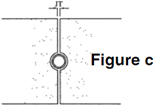ILI Technote On Hand Rails And Posts
The Indiana Limestone Institute believes it is generally best to avoid attaching hand-rail posts (or similar features) to stone copings, caps, steps or cornices. In part, this is because the design loads for hand rails required by most building codes mean these posts can impose very significant loads and stresses at the attachment points. Also, in some cases the method of attachment itself can cause distress in the stone.
ILI suggests that, as a general rule, hand rail posts should pass through and be isolated from the stone and be anchored directly to an adequate underlying structure. (The hand rail supplier should also be consulted for appropriate anchoring methods and other hand rail design considerations). These pass-through joints should have adequate clearance and be properly sealed with a flexible and weather-resistant material so as to isolate the stone from any load or movement that might be transferred from the hand rail posts. One possible method for isolating the post from the stone is shown in Figure a.
Post locations should be coordinated with stone jointing whenever possible, both for appearance and ease of installation. This concept is shown in Figures b and c.



If hand rails or hand-rail posts must be attached directly to the stone, the stone and its anchors and supports must be evaluated for the proposed method of attachment and for the loads that will be applied. Note that the use of expansive grout or expansion-type or corrosive anchors will induce stress in the stone. This stress could be high enough to cause the failure of the stone, particularly if edge distances are not adequate. For this reason, ILI generally discourages the use of expansive anchors for this and other applications and advises against the use of expansive grouts for any Indiana Limestone application.
In all cases corrosion of, or run-off from, the railing system or its posts may cause staining of the stone. ILI recommends that non-corrosive or non-staining materials be used for railing systems and components located at or near Indiana Limestone.
